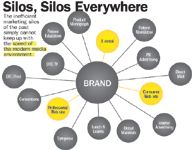Alternative Media: Interactive=Integration
Media have become more fragmented than ever, and sales-force access to customers continues to decline. Pioneers must identify new solutions that improve on tradition.
Within The Last Five Years, nearly every aspect of the pharma industry has been re-engineered to accommodate a world of rapidly evolving technologies and increasing consumer and physician needs. Significant changes in the definitions of sales, marketing, education, and customer relationships have necessitated ongoing and dramatic revisions in the way we approach communication with all core customers. Along the way, information and an increasing recognition of the importance of communications in determining health outcomes have become critical components to the valuation of medicines.

Stephen Wray
One of the most challenging aspects of this metamorphosis is the sheer speed at which customers' communications needs and behaviors are changing. Both professional and consumer audiences have become much more sophisticated—and much more demanding—about their interface with the industry. Gone are the days when these audiences were relatively passive, waiting for pharma to bring its messages to them. Years of Internet connectivity, wireless technology and direct media have spawned an on-demand mindset in a new generation. The customers have spoken: They want greater flexibility, more individualized information, and more relevance and credibility in pharma-driven communications.
This has made the pharma marketer's job much more difficult. Media is more fragmented than ever; sales-force access to professional customers continues to deteriorate; physicians' receptivity to long-revered promotional methods is diminishing; and consumers are expressing an emerging level of skepticism regarding the promotion of medicines in the mass media. Change is never easy, but pioneers can identify solutions that are not only different, but also markedly better from those they have relied on in the past.

In the pharma industry, such marketing pioneers have used new technologies to redefine—or "e-define"—their approach to healthcare marketing, education, and communications from an interactive core. Rather than simply creating impressions, they are gaining competitive advantage by forging sustainable relationships with their core audiences.

Silos, Silos Everywhere
Interactive & Integrated
Global industries, such as automotive and retail, have successfully positioned interactive marketing and the Internet at the core of their overall communications mixes. Pharma has begun to realize the distinct advantages of this model, but many companies still face internal marketing bureaucracies that have siloed their marketing functions into various groups (see "Silos, Silos Everywhere"). Interactive marketing traditionally has been just one more of those silos, largely separated from the brand practice. This environment cannot keep up with the changes taking place in the industry. A complete overhaul of philosophy and vision will have to take place.
It begins by moving the interactive component to the core of the brand marketing strategy. This elevates its strategic role and amplifies the reach and ROI of traditional brand marketing strategies. An interactive core also improves links between consumer and professional communications, and creates a better balance between promotional and educational content. As a result, e-marketing serves to integrate formerly disparate communications channels—such as clinical development, opinion leader interface, conventions and congresses, public relations, and organizational alliances. This has far-reaching implications for the industry at large, since marketing, educational, and collaborative communications extend from Phase II product development across all stages of lifecycle management.
Forming Relationships On Demand
Healthcare professionals are caught between two seemingly incompatible and insurmountable pressures on their practices: managing their time more efficiently in order to improve productivity, and digesting an unprecedented amount of clinical, economic, and regulatory information to improve their practices' quality. Pharma marketers can help them balance these two pressures by moving to a consultative role. Rather than being viewed as an intrusion, industry communications must better align with the needs of the professional audience.
Cadient Group research reveals that the busiest healthcare professionals are just as likely to seek information about products and disease states at 11:00 a.m. (during a break in office hours) as they are at 11:00 p.m. (during a break in the late-night news). Pharma must meet them where they are by creating communications models flexible enough to accommodate either schedule. Unfortunately, most traditional media channels and historical sales force deployment models simply do not have the agility to be available on demand.
Such models also often fail to deliver tailored content with the level of precision that healthcare professional audiences now desire. Several recently published surveys have shown that online destinations are becoming the primary brand and disease information resource for healthcare specialists, ranking even above traditional media, like journals.
An interactive core allows marketers to know the professional audience's hierarchy of needs, to use dynamic segmentation to align messaging, to individualize content delivery, and to seek information more efficiently. Through this approach, pharma marketers can provide multiple levels of value-added service, which can translate into a distinct and sustainable competitive advantage for their brand, franchise, or company.
Marketing pioneers also are adapting their efforts to include a multitude of online services beyond just branded or brand-related information. New tools include sites that enable professionals to establish profiles, against which content is flagged or sorted to assist in research needs. Sites also can provide HCPs with the information and resources their peers find most valuable, and direct them to other interactive resources, such as webinars and peer discussions. PDA-downloadable content, such as diagnostic screening tools, reinforces the value of the consultive relationship. Interactive case-based learning modules allow them to integrate patient care, diagnostics, clinical data overviews, and personalized patient educational materials, all online. And most important, all of these activities are better integrated with communications efforts in other media channels, which keeps messages consistent and amplifies the impact of other communications.
But this approach works for more than just professional communication. An interactive core can support an entire continuum of communications needs: Doctors download PDA-based diagnostic tools and counseling guides to facilitate patient interactions; meanwhile, consumers access unbranded disease awareness sites to learn about conditions and use interactive tools to assess their symptoms.
An e-defined approach provides a pathway for patients and physicians to stay connected. Doctors can "prescribe" a site where patients can access product and condition information and get the chance to enroll in a support program. In addition to encouraging compliance and persistence, this strategy converts patient interest into activism for their own health.
Interactive tools—such as personal medication diaries, daily symptom-assessment tracking tools, and peer-moderated resources like message boards and online testimonials—create information-based relationships with patients and caregivers. These tools also can help healthcare providers assess patient responses, gauge the titration of medications, and fill information gaps that might lead to discontinuance.
E-Defining DTC
The much publicized shift in DTC advertising witnessed over the past year is indicative of pharma's diminishing credibility with consumers, who continue to show their media activism in this area. That's why, as access to information continues to grow, providing the most relevant, timely, credible content to the biggest targeted audience possible is increasingly important and achievable.
In an e-defined marketing environment, information is the new DTC "currency." There's little reason to mourn the loss of the 15-second "Ask your Doctor" spot in this new age of consumer communications, where DTC is driven from an interactive core and becomes a conduit for better communication between the patients and their own healthcare providers. In fact, in many of the new-breed DTC ads, information—whether in the form of brochures, educational DVDs or kits—has supplanted celebrity spokespeople as the mainstay of advertising campaigns.
Similarly, pharma must give consumers a much broader perspective of the information available to them, not just a myopic view of a promotional message. The same can be said for balancing benefit and risk information. The time and space limitations of traditional media may make them unable to fulfill these objectives. But leveraging multiple media strategies and a more expansive use of interactive-channel strategies is sure to improve the industry's performance in the area of appropriate information exchange.
An "information pathway" methodology can identify and segment user needs quickly in order to provide the most relevant information and tools earlier in the value-exchange process. And an interactive strategy should enable each visitor to identify unique needs, access specific resources, and address questions and challenges on individual terms.
Today, we are better able to directly link consumer promotion and educational efforts with sales force interactions for professional audiences. We also can present healthcare providers with parallel information, tools, and training to improve their ability to respond to patients who visit their offices with DTC-driven information. This approach has led to a measurable increase in per-patient value, as well as positive patient and physician perceptions of the value of these interactive initiatives. So it's no surprise that these initiatives now are being showcased as part of sales force and online detailing, as well as DTC advertising and public relations efforts.
Migration to an interactive core allows technology-enabled strategies to keep pace with customer information needs. By providing a conduit for efficient information seeking, more productive physician–patient dialogue, and relationship-based therapy support, we can elevate the value of pharma-driven communications and underscore the industry's leadership vision as activists for improved health outcomes.
Stephen Wray is president and CEO of Cadient Group. He can be reached at stephen.wray@cadient.com

Beyond the Prescription: Pharma's Role in Digital Health Conversations
April 1st 2025Join us for an insightful conversation with Jennifer Harakal, Head of Regulatory Affairs at Canopy Life Sciences, as we unpack the evolving intersection of social media and healthcare decisions. Discover how pharmaceutical companies can navigate regulatory challenges while meaningfully engaging with consumers in digital spaces. Jennifer shares expert strategies for responsible marketing, working with influencers, and creating educational content that bridges the gap between patients and healthcare providers. A must-listen for pharma marketers looking to build trust and compliance in today's social media landscape.